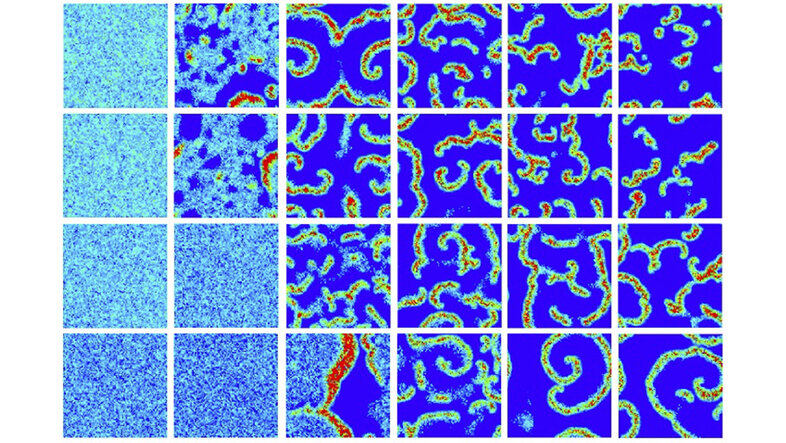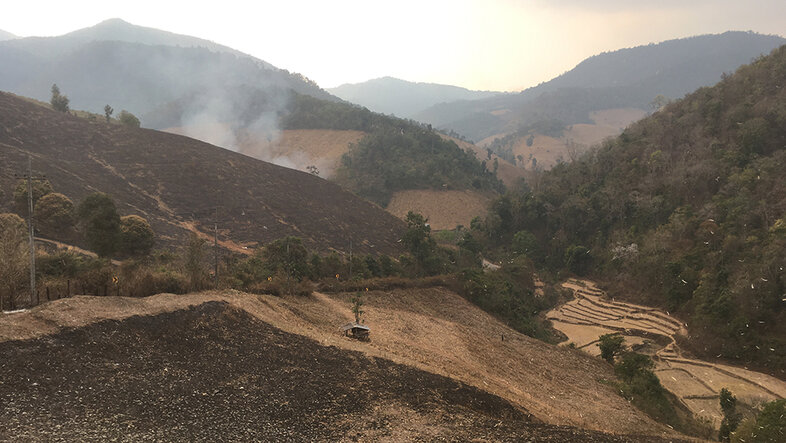Today in front of the abyss, tomorrow one step ahead?
Caterpillars feeding on leaves from a tree and getting eaten by birds – these are the basic ingredients of a famous complex system, which was modelled by US-American researchers in the 1970s. Through this model, the concept of tipping points found its way into ecosystem biology. Be it a food chain, an ecosystem or the planet: All complex systems, to which also humans themselves belong, have commonalities.
First, they consist of clearly separable components that are characterised by interrelationships (trees, caterpillars, birds, etc.). Then, complex system have so-called states of equilibrium. These are states which are constant for longer periods, in which 'forces' in the system are balancing each other and minor changes are corrected: If caterpillars are reproducing too much, birds are detecting them more easily and the 'surplus' is eaten. If the caterpillars are too few, searching for them does not pay off for the birds and the caterpillars can recover.
And third, these systems have tipping points: If a part of a system exceeds a certain threshold, the entire system is apparently changing massively and rapidly. If the trees on which the caterpillars are living are becoming very tall, the caterpillars remain hidden from their predators and reproduce massively. In the end, the number of budworms grows so high that the birds cannot keep up eating them and the caterpillars devour the entire forest. The system has tipped over.
As reaching tipping points in complex systems is often accompanied by diseases, catastrophes and destruction, for example through flooding, drought, species extinction and their social consequences, such as hunger, epidemics and war, we often try to avoid such a scenario. Also social transformations, such as the transport transition or energy transition, are characterised by tipping points. Regardless of whether we regard certain tipping points as positive or negative, we have to understand and be able to predict them if we would like to influence complex systems.
Looking at the world through the eyes of a mathematician
This is where mathematics comes into play. Because: "If you know the equation, you can understand a system's behaviour. And then it does not matter at all whether you are dealing with caterpillars, the climate or movements of groups," explains Sara Merino-Aceituno. The mathematician is conducting research at the University of Vienna addressing emergence, i.e. the question of how the interaction of elements within a system are generating larger structures, for example, how the behaviour of individual birds results in the movement of a flock.
"The wonderful thing about mathematics is that it is so versatile so that you can use the same tools for, at first glance, completely different systems," the scientist describes her special 'mathematical perspective' at the world.
Merino-Aceituno is applying her research in the area of kinetic theory to the investigation of new phenomena in biology, medicine and social sciences. She obtained her PhD degree at the University of Cambridge. Since 2018, she is working at the Faculty of Mathematics at the University of Vienna.
All complex systems have one thing in common, the so-called states of equilibrium, which depend on certain parameters, Merino-Aceituno explains: "Parameters are values that are determined by the environment and that usually do not change. If they do change, they do so much slower than the system variables. They are the adjusting screws that control the development of the system".
The way back is much longer than the way there
And these parameters are playing a central role for another property, which is important for understanding complex systems: the so-called hysteresis. This is the inability of a system to return to its original configuration after a change caused by a small change of the parameters, i.e. reaching the tipping point, by a minor change back. On the contrary, one would have to take the parameters back many steps to bring the system to its initial state. Merino-Aceituno adds, "These reversals are thus possible from a mathematical and theoretical point, but in practice they usually are not".
Her colleague from mathematics, Henk Bruin, who is also working as a mathematician at the University of Vienna and specialises in researching dynamical systems, explains why this is not possible based on the example of the Antarctic ice: "A warming of the atmosphere by one or two degrees Celsius can result in losing the West-Antarctic Ice Sheet. However, to get back the perpetual ice, one would have to cool down the Earth by a significantly higher temperature difference."
We have already seen an example for hysteresis in the beginning illustrated by the caterpillars: Only when the forest is bare and a massive number of caterpillars subsequently die off, the system can recover, with small trees on which birds can quite easily find surplus caterpillars.
Simple preconditions for complex behaviour
Henk Bruin is writing a very simple equation on a sheet of paper (see figure) and explains, "This is the normal form for systems with such tipping points. It is very simple and only has one variable and two parameters. Mathematical models in climate research, ecology and also in economy, however, have numerous variables and parameters. In these complex systems, it is almost certain that you will find a combination of parameters at which a tipping point is reached.
Henk Bruin obtained his doctoral degree at the Delft University of Technology. Since 2012, he has been working at the Faculty of Mathematics at the University of Vienna. He is specialising in dynamical systems, ergodic theory, complex dynamics and continuum theory.
But what if you do not know a system's equation? The true stroke of genius in good models is often not the interpretation of an equation but identifying which factors play a role at all. Often, we do not yet know these factors, neither in highly complex systems, such as the global climate, nor in still very complex subsystems, such as the ecosystem of the soil. How can we then identify tipping points, ideally before we reach them?
Microbial communities are determining the health of our planet
An expert who can answer these questions is Christina Kaiser. She is one of the Directors of the new Cluster of Excellence "Microbiomes Drive Planetary Health" at the University of Vienna and is investigating microbial communities as dynamical systems.
"We cannot know the ideal equation for ecosystems. For this, our measured data are too incomplete. And often we do not even know which factors play which role," says Christina Kaiser about the challenges in the field of ecology, especially in describing global nutrient cycles. This lack of clarity is an especially serious problem where processes at the smallest scale in the soil – so small that the maze-like spatial structure of the soil is becoming the process-determining factor – are linked closely with the truly planetary systems, such as the large permafrost areas, the forests and oceans.
Tipster for tipping points
There are very clear indications for when a system is approaching one or several tipping points: Close to a tipping point, the 'forces' that keep a system in a state of equilibrium are weaker. Therefore, it is becoming harder and harder for a system which is subjected to more or less random fluctuations to regain a state of equilibrium. Christina Kaiser is referring to this as 'critical slowing down' of systems.
At the same time, these fluctuations also make it possibole to jump to other states of equilibrium. Systems close to a tipping point therefore often switch back and forth between two states of equilibrium – a behaviour for which ecosystem researchers are using the term 'flickering'. "This phenomenon is even more interesting when we talk about spatial patterns," says the ecologist, "There, close to tipping points very regular, maze-like patterns form."
And we can actually observe all this in real ecosystems, according to Christina Kaiser. For example, in historical data: 34 million years ago, the Earth abruptly changed from a so-called greenhouse climate to the current icehouse climate, which is characterised by the glaciation of Antarctica. And just before this leap, so-called proxy data, i.e. preserved traces and remains based on which we draw conclusions about the past temperatures, show that temperature fluctuations at the time increasingly became more 'sluggish'.
Christina Kaiser completed her doctorate at the University of Vienna. Following positions at the University of Western Australia and at the International Institute for Applied System Analysis, she has been Group Leader since 2014, and associated professor since 2022 at the Centre for Microbiology and Environmental Systems Science. She is a member of the Environment and Climate Research Hub.

Environment and Climate Research Hub (ECH)
Christina Kaiser is a member of the Environment and Climate Research Hub (ECH), the new multidisciplinary research network within the University of Vienna. It is dedicated to connecting researchers addressing environment, climate, and sustainability from different academic viewpoints. More about the objectives of the network.
Currently, the ECH has 65 members from different faculties and departments of the University of Vienna. All of them carry out research in the field of environment and climate.
In complex systems, the details determine the state of the whole
"Understanding these dynamics better is essential to take countermeasures," says Christina Kaiser about her motivation to understand soils as complex systems, where often tiny details emerge as game changers for the entire whole. "Because for a healthy planet, it is important to retain systemic balances so that all species can live well on it."
In the end, crossing ecological tipping points results in catastrophic changes that make good life on Earth completely impossible. "To prevent such a scenario, it is high time to counteract resolutely and quickly, which can only be achieved by means of massive social and political change," the ecologist emphasises.
Habitability as an interactive property
Massive social and political change are imminent in any case, also in the worst-case scenario of our driving ecosystems beyond their tipping points. At the Department of Geography and Regional Research, Harald Sterly is addressing the question of how environmental changes are influencing the habitability of regions and how humans react to them.
In the project HABITABLE, Harald Sterly is asking very basic questions, such as: What does "habitable" actually mean? "A dry savannah is indeed inhabitable for rice paddy farmers, but the nomadic pastoralists are well adapted to these conditions and can survive there rather well," starts the human geographer on the question of the definition: Conversely, in eastern Germany, for example, there are many areas in which agriculture is undoubtedly possible but which are increasingly depopulated. "Habitability is a property defined by the interaction between humans and a place," says Sterly.
In his doctoral thesis, Sterly wrote about mobile communication and translocal social relationships of migrants between the countryside and cities in Bangladesh. He then coordinated a research project about megaurban dynamics and informality in Bangladesh and China as well as the interrelations between migration, translocal connections and social resilience in Thailand. Now he is working as a human geographer at the Department of Geography and Regional Research of the University of Vienna. The behaviour is clear, its interpretation difficult.
Despite all ambiguity surrounding their definition, we can clearly observe tipping points in many societies. According to Harald Sterly, these can be observed easily, if behaviours, such as emigration, birth rates, life styles, etc. suddenly exhibit profound changes. "However, whether these changes are good or bad, is also a question of prerogative of interpretation," adds Sterly and warns us of a settlement bias in this context. Usually, we are basically considering migration and mobility as something extraordinary in contrast to settling down. Sterly says, "We are inclined to perceive emigration always as something negative. However, in many high-risk areas, people would often indeed like to move away, but the conditions do not allow for that." Therefore, also immobility can be a problem, especially in view of the deteriorating environmental conditions.
On the other hand, there is also emigration which is not motivated by the emigrants themselves but which is initiated by politics. For example, the Philippine government, after the typhoon Haiyan in 2013, has assessed some areas as 'insecure' and prohibited the evacuated population to return to these areas.
The systemic and the political perspective
"Social systems partially follow other principles than, for example, ecological ones," explains Sterly, "For these human systems, power, symbols and discourse play a significant role." The researcher from the University of Vienna calls attention to the fact that a systemic perspective in fact makes sense in geography but it additionally needs a political and ecological perspective, which foregrounds conflicts and power dynamics.
At least in democratic systems, which are shaped by 'competing mainstream narratives', this anyhow leads to new tipping points, referred to as transitions, especially where previously probably dismissed opinions and niche interests suddenly gain ground among a majority and shap the political discourse. The examples given by Sterly are the availability of vegan products in the supermarket, riding a bicycle in the city or the wide-spread installation of photovoltaic systems. Eventually, a point is reached, where it is suddenly interesting from an economic point of view or is just accepted by society to build up the necessary infrastructures.
For Christina Kaiser, these social tipping points are a reason for hope. "We are currently running the risk of failing all our efforts, first of all, the 1.5-degree target, because there are so many opposing forces despite very important movements which created much pressure, a lot of attention and also much real sympathy. If we reach such a 'positive' social tipping point and then maybe it also becomes an economic issue, it could be that changes go quickly and take hold."
The next step is certain
Tipping points are all around us and there is no alternative to crossing some of them. At the University of Vienna, academics from different faculties are conducting research to understand what is needed to still change current developments. Sara Merino-Aceituno, Henk Bruin, Christina Kaiser and Harald Sterly agree that this is still not enough. In addition to the academic findings, we also need a political consensus over the severity of the situation and a broad part of society participating in tackling the crisis. Here, especially, there are still major frictional losses.
It is now a question of reaching social tipping points. And according to the four experts from the University of Vienna, the questions we have to face include the following: Can we muster the same political will, with which we were able to overcome the COVID-19 pandemic, quickly enough to avoid the most dangerous developments of environmental change and to cushion the worst consequences? And in doing so, will we also manage to consider people thousands of kilometers away who are struggling with the consequences of our actions here? Or do we remain in our current political equilibrium until first our environment and then our social environment create new facts? (ds)
- More about Sara Merino-Aceituno
- More about Henk Bruin
- Fakulty of Mathematics
- More about Christina Kaiser
- Department of Microbiology and Ecosystem Science
- Environment and Climate Research Hub
- More about Harald Sterly
- Department of Geography and Regional Research
- HABITABLE project website
- Cluster of Excellence "Microbiomes Drive Planetary Health"
- About the FWF Clusters of Excellence, in which the University of Vienna is participating
- Events and workshops at the University of Vienna on the topic of planetary health (German)
- MOOC on natural disasters: Natural hazards, natural risks and disaster management (German, from 22 May 2023)
- MOOC on climate change (KLIMO): Scientific Basics (German)
- Semester question 'Planetary Health' in the course directory (German)
- Environment and Climate Research Hub






